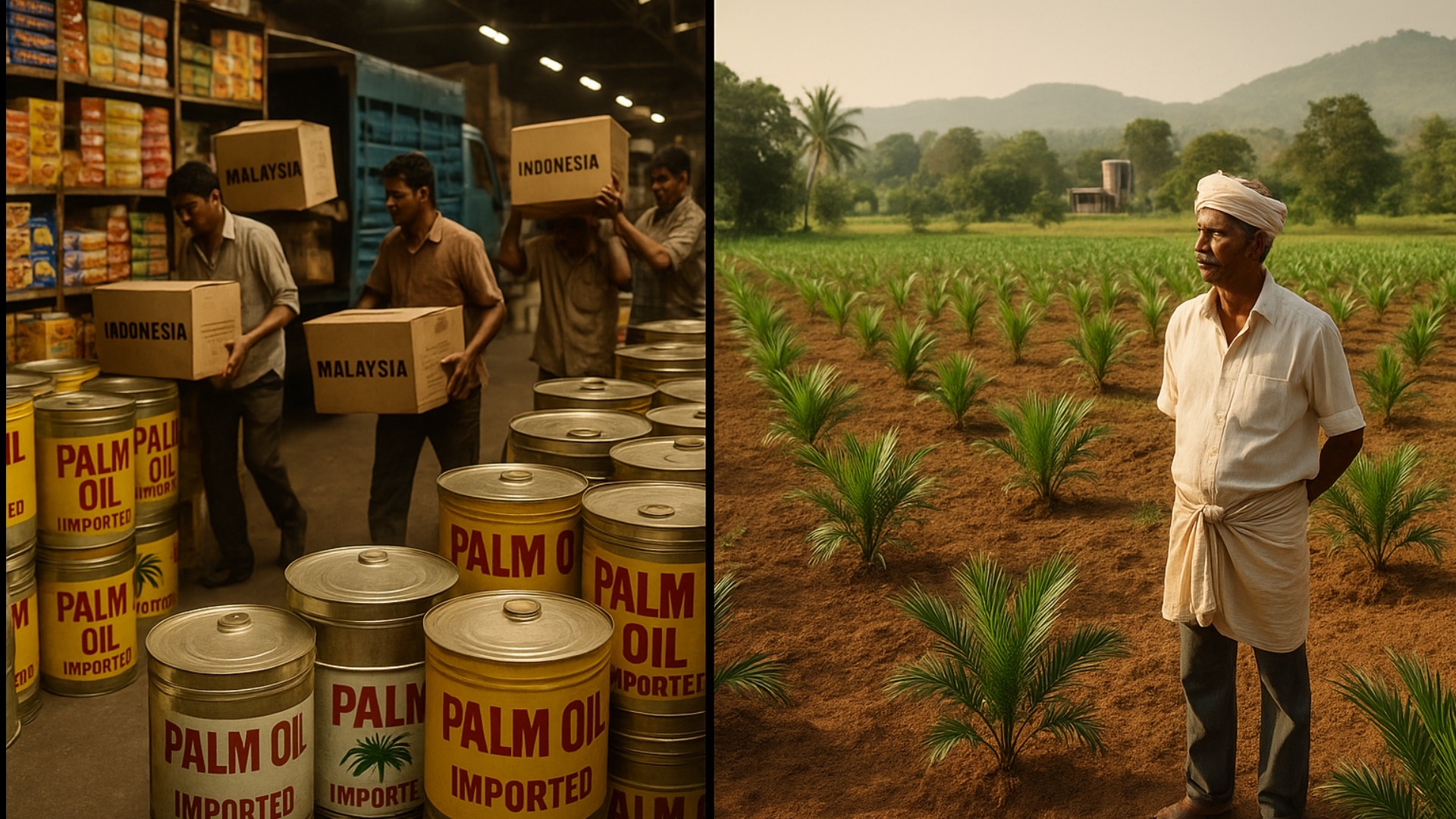What’s the one important component needed while cooking, and without it you can’t even cook, if not all, at least the majority?
Oil, right? We call it cooking oil or edible oil. So, there are multiple types of oil that people in India use, such as sunflower oil, groundnut oil, coconut oil in some places, and mostly palm oil.
We use edible oils for various purposes, such as cooking, garnishing, seasoning, and frying. India consumes the highest amount of palm oil across the world. We are the largest consumer of Palm Oil. Naturally, you’d think we produce a lot of it too, right?
Well, the answer is no.
We don’t have enough production of palm oil in India. We are depending on Indonesia, Malaysia, and Thailand for a major chunk of our requirements.
According to the stats available, India consumes nearly 23 to 25 million tons of edible oil in a single year. And amongst that, the major consumed oil is palm oil, which stands at around 8-10 million tons in a single year. But interestingly, 15-16 million tons of edible oils consumed in India were met through imports.
Have you ever thought why Indians are consuming palm oil even though it is not available domestically on a large scale?
First and most importantly, palm oil is cheap. Compared to other oils like sunflower, groundnut, or mustard, palm oil costs significantly less. For a country like India, where affordability matters especially for middle- and lower-income households, palm oil becomes an easy choice.
Second, it’s highly versatile. Palm oil can be used for frying, cooking, baking, and even in processed foods. It has a longer shelf life, which makes it popular in packaged goods like biscuits, instant noodles, chips, and snacks. Even industries use it in products like soap, shampoo, detergents, and cosmetics. India’s domestic production of edible oils is not enough to meet the total demand. So, palm oil fills that gap efficiently. Indians started to consume more palm oil over the period.
As of 2023, we were consuming 9 million tons of palm oil, but do you know how much it was in 1993? Any guess? It was just 0.2 million tons. But it has spiked up significantly to today’s numbers. In 2003, we were consuming 3.3 million tons of palm, and by 2013, we were consuming 8.3 million tons.
So, it has clearly shown us how palm oil consumption has spiked.
We understood the reasons for the overall demand, why there is a demand, and how we are meeting the requirements.
Now it all leads us to a simple question.
Why is India not producing enough? Right. Let’s delve deeper into it as well.
Today we are producing about 400,000 tons of oil, and there are some estimates saying this number will reach 1.2 to 1.5 million tons in the next 6 years.
If that happens, the import dependency will reduce but not completely. There are some reasons why India is not able to produce more palm oil domestically.
- Limited Suitable Climate
Palm oil needs hot and humid tropical weather all year round. But in India, only certain regions like Andhra Pradesh, Kerala, Karnataka, Assam, and Mizoram have the right climate. This is only applicable to limited regions. We simply don’t have vast areas with ideal conditions like Indonesia or Malaysia. - Long Gestation Period
Palm trees take 4 to 6 years to start producing fruit. That means a farmer has to invest time, land, and money and wait years for income.
In contrast, crops like paddy or wheat are harvested in 3–4 months. For small farmers, waiting years without returns is a big risk. - High Water Needs
Palm plantations need a lot of water, especially in the early stages. In many Indian regions where land is available, water is already scarce. So, farmers hesitate to shift to a water thirsty crop.
So, there is some problem for farmers to do it, so how has the government supported them over the period?
This point takes us back to 1991. When India opened up its economy in 1991, one of the biggest reforms was liberalizing trade, and that included edible oil imports.
Before this, India followed an “import substitution” strategy; we tried to grow everything at home. But after liberalization, cheaper edible oils, especially palm oil from Malaysia and Indonesia, started flowing in. This made palm oil easily available and affordable, which was great for consumers and industries. That was one of the reasons why less attention was paid to domestic production. Instead of investing in long-term palm plantations, the focus shifted to importing more because it was cheaper and quicker. Farmers didn’t get strong incentives, and palm oil cultivation remained limited to small parts in Andhra Pradesh and a few other states.
In 2004, the government launched the Oil Palm Development Programme (OPDP) under the National Horticulture Mission. It aimed to increase cultivation by giving subsidies and technical support. But results were slow as there was no major policy push, and progress remained limited.
For nearly 20 years, India remained stuck, but consumption was rising and production stayed flat. Imports kept growing.
But in 2021, for the first time, palm oil got focused national-level attention with the launch of the National Mission on Edible Oils – Oil Palm (NMEO-OP). It was launched with a budget allocation of INR 11,000+ crore.
The main target of this mission is to expand oil palm cultivation to 10 lakh hectares by 2025-26. The main focus areas are the Northeast, Andaman & Nicobar, farmer incentives, assured pricing, and mill development. It’s the most aggressive policy India has ever introduced for palm oil and, maybe, the first step toward reducing dependency the right way.
Though we are doing all of this, it still takes 6 years to get some major control over this scenario. India is building rockets, creating billion-dollar startups, and leading the world in digital payments.
But maybe our next big success story should be about something as simple as cooking oil.
Today, the world is full of problems like wars, export bans, and delivery delays. In such times, we shouldn’t depend on other countries for something that’s used in every Indian kitchen.
It’s time we use new technology, better farming methods, and smart government support to grow more oil here in India.
Let’s aim to produce our own instead of always importing from others.
Also Read: The Growth of India’s Gym Industry and Cult Fit’s Dominance








